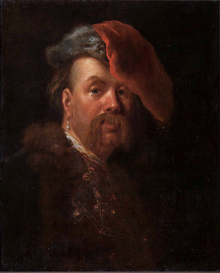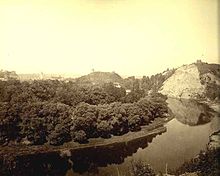Gáspár Bekes
Gáspár Bekes von Kornyát (also Gáspár de Corniath Bekes , Kornyáti Bekes Gáspár or Kaspar Bekes ; * 1520 - † November 7, 1579 in Hrodna ) was a Hungarian-Transylvanian magnate , Count of Fogarasch and temporary pretender to the throne of the Principality of Transylvania .
Life
Origin, family

Gáspár Bekes came from an old Hungarian noble family. His father László was the deputy commander of the Lugosch fortress in the Banat . After the death of his first wife, Anna Harinnay, Bekes married Anna Sárkándy on November 30, 1567. He confessed to Unitarianism , whose followers outside of Transylvania were persecuted as heretics almost everywhere in Europe . Nevertheless, Bekes obtained the support of the Catholic Emperor Maximilian II in the throne dispute with the Catholic Stephan Báthory .
In the service of Johann Sigismund Zápolyas
As a close advisor to Johann Sigismund Zápolya , Prince of Transylvania, Bekes made a career at his court and eventually rose to become treasurer. At times he represented the prince as an envoy at the court of the Ottoman sultan in Constantinople and with the Roman-German emperor . With Maximilian II he negotiated the Treaty of Speyer , which was signed on August 16, 1570 at the Reichstag there . In it, Emperor Maximilian was recognized as King of Hungary and thus as overlord of Transylvania.
Controversy for the throne with Stephan Báthory
Since Prince Johann Sigismund had no legal heir, he appointed Gáspár Bekes as his successor. After his death, the assembly of estates of Transylvania in Alba Iulia on May 25, 1571 did not elect Bekes, but Stephan Báthory as the new prince. The estates were supported by the Ottoman Sultan Selim II , who, like the Habsburg emperor, claimed rule over Transylvania. At that time Bekes was still at the court of Maximilian II and won his support in the fight against Báthory. He raised an army with which he penetrated from Upper Habsburg Hungary into Transylvania in the summer of 1573, but had to withdraw again in autumn. When Maximilian and Báthory settled their conflict at short notice, Bekes traveled to Constantinople, where he sought the sultan's support in vain. In 1574, however, the disputes between the emperor and Stephan Báthory flared up again, as they both competed for the crown of Poland-Lithuania. Supported by Maximilian, by nobles who were dissatisfied with Báthory's rule and the ethnic group of the Szekler , who enjoyed a certain autonomy within Transylvania , Bekes triggered another uprising. Stephan Báthory also struck this down with the help of his brother Christoph . After the lost battle at Kerelőszentpál on June 10, 1575, Bekes narrowly escaped to Vienna. Báthory had many of his aristocratic followers executed and declared him an enemy of the country and expropriated. The Szeklers lost their previous privileges.
Ally of Báthories
In 1576, Emperor Maximilian died and his rival Báthory was elected King of Poland in Kraków. With this, Bekes' endeavors lost any chance of success. Despite the existing religious differences, he reconciled himself with his rival and became his loyal supporter and advisor in his final years. He fought for Báthory at the head of Hungarian cavalry troops in the Danzig War and later in the Livonian War against Tsar Ivan the Terrible . Bathory awarded him the Starostei Lanckorona near Cracow and other lands for his services .
Death and burial
After the capture of Polatsk in the Livonian War, Gáspár Bekes fell ill and died in Hrodna. His body was taken to Vilnius , but all Christian communities in the city refused to bury a Unitarian in one of their cemeteries. Bekes was therefore buried outside the city - in the area of today's Kalnu Park - on a hill later named after him, which was crowned by a 20 meter high, octagonal tower. The part of Bekes Hill on which the tower and tomb were located was eroded by erosion and flooding of the Vilnia River by the end of the 19th century .
Individual evidence
- ↑ Peter F. Sugar: Southeastern Europe Under Ottoman Rule, 1354-1804 , University of Washington Press, 1983, pp. 156-157
- ↑ Felicia Rosu: Elective Monarchy in Transylvania and Poland-Lithuania, 1569-1587 , Oxford University Press 2018, p. 165
- ↑ Pál Fodor: Making a Living on the Frontiers: Volonteers in the Sixteenth-Century Ottoman Army , in: Pál Fodor and Géza Dávid (Eds.): Ottomans, Hungarians, and Habsburgs in Central Europe: The Military Confines in the Era of Ottoman Conquest , Verlag Brill, Leiden, Boston Cologne 2000, p. 256
| personal data | |
|---|---|
| SURNAME | Bekes, Gáspár |
| ALTERNATIVE NAMES | Bekes von Kornyát, Gáspár; Bekes, Gáspár de Corniath; Kornyáti Bekes, Gáspár; Bekes, Kaspar |
| BRIEF DESCRIPTION | Hungarian-Transylvanian nobleman and temporarily pretender to the throne of the Principality of Transylvania |
| DATE OF BIRTH | 1520 |
| DATE OF DEATH | November 7, 1579 |
| Place of death | Hrodna |

